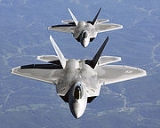
Supermaneuverability
Encyclopedia

Aircraft
An aircraft is a vehicle that is able to fly by gaining support from the air, or, in general, the atmosphere of a planet. An aircraft counters the force of gravity by using either static lift or by using the dynamic lift of an airfoil, or in a few cases the downward thrust from jet engines.Although...
defined as a threshold of attitude control exceeding that which is possible by pure aerodynamic maneuverability; in other words, a controlled loss of control beyond normal abilities. It is a trait of some advanced fourth-generation and 4.5-generation fighter aircraft
Fighter aircraft
A fighter aircraft is a military aircraft designed primarily for air-to-air combat with other aircraft, as opposed to a bomber, which is designed primarily to attack ground targets...
which has become standard in fifth-generation aircraft such as the F-22 Raptor
F-22 Raptor
The Lockheed Martin/Boeing F-22 Raptor is a single-seat, twin-engine fifth-generation supermaneuverable fighter aircraft that uses stealth technology. It was designed primarily as an air superiority fighter, but has additional capabilities that include ground attack, electronic warfare, and signals...
and the Russian Sukhoi PAK FA
Sukhoi PAK FA
The Sukhoi PAK FA is a twin-engine jet fighter being developed by Sukhoi OKB for the Russian Air Force. The Sukhoi T-50 is the prototype for PAK FA. The PAK FA is one of only a handful of stealth jet programs globally...
(T-50). Post-stall technology is increasingly used in recent years to advance supermaneuverability by the use of vectored thrust in 4.5 and 5th generation aircraft.
Aerodynamic maneuverability vs supermaneuverability
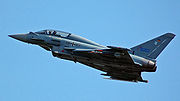
.jpg)
Aileron
Ailerons are hinged flight control surfaces attached to the trailing edge of the wing of a fixed-wing aircraft. The ailerons are used to control the aircraft in roll, which results in a change in heading due to the tilting of the lift vector...
s, elevators
Elevator (aircraft)
Elevators are flight control surfaces, usually at the rear of an aircraft, which control the aircraft's orientation by changing the pitch of the aircraft, and so also the angle of attack of the wing. In simplified terms, they make the aircraft nose-up or nose-down...
, flaps
Flap (aircraft)
Flaps are normally hinged surfaces mounted on the trailing edges of the wings of a fixed-wing aircraft to reduce the speed an aircraft can be safely flown at and to increase the angle of descent for landing without increasing air speed. They shorten takeoff and landing distances as well as...
, air brakes
Air brake (aircraft)
In aeronautics, air brakes or speedbrakes are a type of flight control surface used on an aircraft to increase drag or increase the angle of approach during landing....
and rudder
Rudder
A rudder is a device used to steer a ship, boat, submarine, hovercraft, aircraft or other conveyance that moves through a medium . On an aircraft the rudder is used primarily to counter adverse yaw and p-factor and is not the primary control used to turn the airplane...
. Some of these control surfaces can be combined—such as in the "rudder-vaters" of a V-tail
V-tail
In aircraft, a V-tail is an unconventional arrangement of the tail control surfaces that replaces the traditional fin and horizontal surfaces with two surfaces set in a V-shaped configuration when viewed from the front or rear of the aircraft...
configuration—but the basic properties are unaffected. When a control surface is moved to present an angle to the oncoming airflow, the control surface redirects the air in a different direction and, by Newton's Third Law, an equal opposing force is applied by the air to the control surface and thus the aircraft. The angle of control surface deflection and resulting directional force on the aircraft are controlled by the pilot to maintain the desired attitude, such as pitch, roll and heading, and also to perform aerobatic maneuvers that rapidly change the aircraft's attitude. For traditional maneuvering control to be maintained, the aircraft must maintain sufficient forward velocity and a sufficiently low angle of attack
Angle of attack
Angle of attack is a term used in fluid dynamics to describe the angle between a reference line on a lifting body and the vector representing the relative motion between the lifting body and the fluid through which it is moving...
to provide airflow over the wings (maintaining lift) and also over its control surfaces. As airflow decreases so does effectiveness of the control surfaces and thus the maneuverability. On the other hand, if the angle of attack exceeds its critical value, the airplane will stall
Stall (flight)
In fluid dynamics, a stall is a reduction in the lift coefficient generated by a foil as angle of attack increases. This occurs when the critical angle of attack of the foil is exceeded...
. Pilots are trained to avoid stalls during aerobatic maneuvering and especially in combat, as a stall can permit an opponent to gain an advantageous position while the stalled aircraft's pilot attempts to recover.
The speed at which an aircraft is capable of its maximum aerodynamic maneuverability is known as the corner airspeed; at any greater speed the control surfaces cannot operate at maximum effect due to either airframe stresses or induced instability from turbulent airflow over the control surface. At lower speeds the redirection of air over control surfaces, and thus the force applied to maneuver the aircraft, is reduced below the airframe's maximum capacity and thus the aircraft will not turn at its maximum rate. It is therefore desirable in aerobatic maneuvering to maintain corner velocity.
In an aircraft possessing supermaneuverability, the pilot is able to maintain a high degree of maneuverability below corner velocity, and at least limited attitude control without altitude loss below stall speed. Such an aircraft is capable of maneuvers that are impossible with a purely aerodynamic design. More recently an increasing use of jet-powered, instrumented unmanned vehicles ["research drones"] have increased the potential flyable angle of attack beyond 90 degrees and well into the post-stall safe flight domains, and have also replaced some of the traditional uses of wind tunnels.
Evidence
There is no strict set of guidelines an aircraft must meet or features it must have in order to be classified as supermaneuverable. However, as supermaneuverability itself is defined, an aircraft capable of performing high alphaAngle of attack
Angle of attack is a term used in fluid dynamics to describe the angle between a reference line on a lifting body and the vector representing the relative motion between the lifting body and the fluid through which it is moving...
maneuvers that are impossible for most aircraft are evidence of an aircraft's supermaneuverability. Such maneuvers include Pugachev's Cobra
Pugachev's Cobra
In aerobatics, Pugachev's Cobra is a dramatic and demanding manoeuvre in which a plane flying at a moderate speed suddenly raises the nose momentarily to the vertical position and slightly beyond, before dropping it back to normal flight. It uses a potent engine thrust to maintain approximately...
and the Herbst maneuver
Herbst maneuver
The Herbst maneuver is an air combat maneuver which uses post-stall technology such as thrust vectoring and advanced flight controls to achieve high angles of attack. The Herbst maneuver allows an aircraft to quickly reverse direction using a combination of high angle-of-attack and rolling...
(also known as the "J-turn").
However, some aircraft are capable of performing Pugachev's Cobra without the aid of features that normally provide post-stall maneuvering such as thrust vectoring
Thrust vectoring
Thrust vectoring, also thrust vector control or TVC, is the ability of an aircraft, rocket or other vehicle to manipulate the direction of the thrust from its engine or motor in order to control the attitude or angular velocity of the vehicle....
. Advanced fourth generation fighters such as the Su-27, MiG-29, and F/A-18 along with their variants have been documented as capable of performing this maneuver using normal, non-thrust vectoring engines. The ability of these aircraft to perform this maneuver is based in inherent instability like that of the F-16; the MiG-29 and Su-27 families of jets are designed for desirable post-stall behavior. Thus, when performing a maneuver like Pugachev's Cobra the aircraft will stall as the nose pitches up and the airflow over the wing becomes separated, but naturally nose down even from a partially inverted position, allowing the pilot to recover complete control.
The Cobra, as performed by non-thrust vectoring aircraft, still depends on the aircraft moving through air; however, it does not involve the aircraft's aerodynamic surfaces and normal laminar airflow, but rather the whole airframe as a solid shape travelling through air, and its center of gravity in relation to the thrust vector. Being performed under conditions far beyond normal aerodynamic control and well into a stall without thrust vectoring, this is a form of passive supermaneuverability, possible because of aircraft design rather than thrust vectoring, which provides a way to actively control the aircraft well outside of the normal flight envelope.
The Herbst Maneuver
Herbst maneuver
The Herbst maneuver is an air combat maneuver which uses post-stall technology such as thrust vectoring and advanced flight controls to achieve high angles of attack. The Herbst maneuver allows an aircraft to quickly reverse direction using a combination of high angle-of-attack and rolling...
, however, is believed to be impossible without thrust vectoring
Thrust vectoring
Thrust vectoring, also thrust vector control or TVC, is the ability of an aircraft, rocket or other vehicle to manipulate the direction of the thrust from its engine or motor in order to control the attitude or angular velocity of the vehicle....
as the "J-turn" requires a half-roll in addition to pitching while the aircraft is stalled, which is impossible using conventional control surfaces. The Pugachev's Cobra can be performed with less change in altitude if vectored thrust is used, as the aircraft can be made to pitch far more rapidly, both inducing the stall before the aircraft significantly gains altitude and recovering level attitude before altitude is lost.
Characteristics
Although as aforementioned no fixed set of features defines a supermaneuverable aircraft explicitly, virtually all aircraft considered supermaneuverable have a majority of common characteristics that aid in maneuverability and stall control.Post-stall characteristics
The key difference between a pure aerodynamic fighter and a supermaneuverable one is generally found in its post-stall characteristics. A stall, as aforementioned, happens when the flow of air over the top of the wing becomes separated due to a high angle of attackAngle of attack
Angle of attack is a term used in fluid dynamics to describe the angle between a reference line on a lifting body and the vector representing the relative motion between the lifting body and the fluid through which it is moving...
(this can be caused by low speed, but its direct cause is based on the direction of the airflow contacting the wing); the airfoil then loses its main source of lift and will not support the aircraft until normal airflow is restored over the top of the wing.
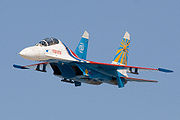
A supermaneuverable aircraft allows the pilot to maintain at least some control when the aircraft stalls, and to regain full control quickly. This is achieved largely by designing an aircraft that is highly maneuverable, but will not deep stall (thus allowing quick recovery by the pilot) and will recover predictably and favorably (ideally to level flight; more realistically to as shallow a nose-down attitude as possible). To that design, features are then added that allow the pilot to actively control the aircraft while in the stall, and retain or regain forward level flight in an extremely shallow band of altitude that surpasses the capabilities of pure aerodynamic maneuvering.
Thrust-to-weight ratio
A key feature of supermaneuvering fighters is a high thrust-to-weight ratio; that is, the comparison of the force produced by the engines to the aircraft's weight, which is the force of gravity on the aircraft. It is generally desirable in any aerobatic aircraft, as a high-thrust-to-weight ratio allows the aircraft to recover velocity quickly after a high-G maneuver. In particular, a thrust-to-weight ratio greater than 1:1 is a critical threshold, as it allows the aircraft to maintain and even gain velocity in a nose-up attitude; such a climb is based on sheer engine power, without any lift provided by the wings to counter gravity, and has become crucial to aerobatic maneuvers in the vertical (which are in turn essential to air combat).High thrust-to-weight is essential to supermaneuvering fighters because it not only avoids many situations in which an aircraft can stall (such as during vertical climbing maneuvers), but when the aircraft does stall, the high thrust-to-weight ratio allows the pilot to sharply increase forward speed even as the aircraft pitches nose-down; this reduces the angle the nose must pitch down in order to meet the velocity vector, thus recovering more quickly from the stall. This allows stalls to be controlled; the pilot will intentionally stall the aircraft with a hard maneuver, then recover quickly with the high engine power.
Beginning in the late fourth-generation and through Generation 4.5 of aircraft development, advances in engine efficiency and power enabled many fighters to approach and exceed thrust-to-weight ratios of 1:1. All current and planned fifth-generation fighters will exceed this threshold.
High aerodynamic maneuverability
Even though true supermaneuverability lies outside the realm of what is possible with pure aerodynamic control, the technologies that push aircraft into supermanuvering capability are based on what is otherwise a conventional aerodynamically-controlled design. Thus, a design that is highly maneuverable by traditional aerodynamics is a necessary base for a supermaneuverable fighter. Features such as large control surfaces which provide more force with less angular change from neutral which minimizes separation of airflow, lifting bodyLifting body
A lifting body is a fixed-wing aircraft configuration in which the body itself produces lift. In contrast to a flying wing, which is a wing with minimal or no conventional fuselage, a lifting body can be thought of as a fuselage with little or no conventional wing...
design including the use of strakes
Strake (aviation)
In aviation, a strake is an aerodynamic surface generally mounted on the fuselage of an aircraft to improve the airflow and hence the flight characteristics.In general a strake is longer than it is wide, in contrast to a winglet or a moustache....
, which allow the fuselage of the aircraft to create lift in addition to that of its wings, and low-drag design, particularly reducing drag at the leading edges of the aircraft such as its nose cone, wings and engine intake ducts, is all essential to creating a highly-maneuverable aircraft.
Some designs, like the F-16 (which in current production form is regarded as highly maneuverable, but only the F-16 VISTA tech demonstrator is considered supermaneuverable) are designed to be inherently unstable; that is, the aircraft, if completely uncontrolled, will not tend to return to level, stable flight after a disturbance as an inherently stable design will. Such designs require the use of a "fly-by-wire" system where a computer corrects for minor instabilities while also interpreting the pilot's input and manipulating the control surfaces to produce the desired behavior without inducing a loss of control. Thus corrected for, the instability of the design creates an aircraft that is highly maneuverable; free from the self-limiting resistance that a stable design provides to desired maneuvers, an intentionally unstable design is capable of far higher rates of turn than would otherwise be possible.
Canard controls
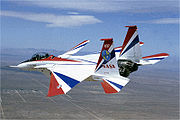
Canard (aeronautics)
In aeronautics, canard is an airframe configuration of fixed-wing aircraft in which the forward surface is smaller than the rearward, the former being known as the "canard", while the latter is the main wing...
is an elevator control surface placed forward of the wings. Sometimes, as with the B-1B, they are simply used to stabilize flexible portions of the fuselage or provide very minute attitude changes, but they are used often as a supplement to or full replacement of tail-mounted stabilator
Stabilator
A stabilator is an aircraft control surface that combines the functions of an elevator and a horizontal stabilizer...
s.
The theory behind canards as the sole elevator surface is that no elevator configuration aft of the wings is truly satisfactory for maneuvering purposes; the airflow over the wings creates turbulence, however small, and thus affects elevators placed directly behind the wings. Placement below the wings (common on many fighters) exposes the elevators to even greater turbulence from under-wing ordnance. The original solution to such problems, the T-tail, has been largely discredited as being prone to dangerous "deep stalls". Other solutions like the V-tail place the combination rudder-elevator surfaces out of the wings' airflow, but reduce the effectiveness of the control surface in the pure pitch and yaw axes. In addition, a full swept wing, which is favorable for speed, leaves no other place for the elevators than forward of the wings and thus delta-wing designs like the Saab Gripen use them by necessity.
As a supplement to traditional elevators, canards vastly increase control surface area, and often increase the critical angle of attack of the wings as the canard directs air more directly toward the leading edge of the wing. They can also be designed to operate independently (i.e. counter-rotate), thus also acting as ailerons.
Canards are not a requirement, and can have disadvantages including reduced pilot visibility, increased mechanical complexity and fragility, and increased radar signature. The F-22, for example, does not incorporate canards, mostly for stealth reasons. Many technology demonstrators and maneuverability testbeds such as the F-15 S/MTD incorporated canards, even when the production aircraft they were based on did not. Production fighters like the Eurofighter Typhoon
Eurofighter Typhoon
The Eurofighter Typhoon is a twin-engine, canard-delta wing, multirole combat aircraft, designed and built by a consortium of three companies: EADS, Alenia Aeronautica and BAE Systems; working through a holding company, Eurofighter GmbH, which was formed in 1986...
, Dassault Rafale
Dassault Rafale
The Dassault Rafale is a French twin-engine delta-wing multi-role jet fighter aircraft designed and built by Dassault Aviation. Introduced in 2000, the Rafale is being produced both for land-based use with the French Air Force and for carrier-based operations with the French Navy...
and Saab Gripen all use a delta-wing configuration with canard surfaces, while variants of the Su-27 including the Su-30, Su-33 and Su-37 all use canards to supplement traditional tail-mounted elevators.
Thrust vectoring
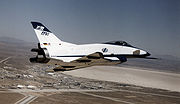
Thrust vectoring
Thrust vectoring, also thrust vector control or TVC, is the ability of an aircraft, rocket or other vehicle to manipulate the direction of the thrust from its engine or motor in order to control the attitude or angular velocity of the vehicle....
, in which the geometry of the exhaust nozzle of a traditional jet engine can be modified to angle the engine's thrust in a direction other than directly to the rear (i.e., upwards or downwards). This applies force to the rear of the aircraft in the opposite direction similar to a conventional control surface, but unlike a control surface the force from the vectored thrust is dependent on current engine thrust, not airspeed; thus thrust vectoring not only augments control surfaces (generally that of the elevators) at speed, but allows the aircraft to retain maximum maneuverability below corner speed and some attitude control below stall speed while in maneuvers. Technology demonstrators such as the X-31, F-16 VISTA
F-16 VISTA
|-See also:-External links:* * * * *...
and F-15 S/MTD were built to showcase the capabilities of an aircraft using this technology; it has since been incorporated into pre-production and production fighters such as the F-22 Raptor
F-22 Raptor
The Lockheed Martin/Boeing F-22 Raptor is a single-seat, twin-engine fifth-generation supermaneuverable fighter aircraft that uses stealth technology. It was designed primarily as an air superiority fighter, but has additional capabilities that include ground attack, electronic warfare, and signals...
. Eastern Bloc design companies have also introduced this technology into variants of fourth-generation aircraft such as the MiG-29 and Su-27 to produce the MiG-29OVT tech demonstrator and Su-30MKI
Su-30MKI
The Sukhoi Su-30MKI is an air superiority fighter jointly developed by Russia's Sukhoi and India's Hindustan Aeronautics Limited for the Indian Air Force...
air superiority fighter respectively, and planned fifth-generation Russian-designed aircraft such as the PAK-FA will use the technology as well.
Thrust vectoring is most useful while performing maneuvers such as the aerial J-turn
Herbst maneuver
The Herbst maneuver is an air combat maneuver which uses post-stall technology such as thrust vectoring and advanced flight controls to achieve high angles of attack. The Herbst maneuver allows an aircraft to quickly reverse direction using a combination of high angle-of-attack and rolling...
, where the nose of the aircraft is pointed upwards (and thus the engine thrust counters gravity as well as providing attitude control). It is generally considered impossible, in fact, to perform a true J-turn maneuver without vectored thrust. Other maneuvers that are considered impossible to perform under control using only aerodynamic maneuvering include the Bell (a 360° loop with negligible altitude change) and the controlled flat spin (360° of yaw around a point of rotation that lies inside the aircraft).
Assessment
Pilots flying supermaneuverable aircraft can pitch their noses up to extreme angles of attack (as much as 70 degrees) allowing them to potentially gain an advantage, by being able to lock on to a target and fire at it, but at the expense of the altitude and/or speed of the aircraft. Quantifying such a potential advantage using metrics was not really possible in the early 1990s - traditional metrics such as instantaneous or sustained turn rate plots did not highlight the differences which pilots described when flying such aircraft. Several research projects were conducted through the 1990s and one in particular, entitled "Performance Assessment of Fighter Aircraft incorporating Advanced Technologies"by Dr Ant Kutschera, not only reviewed existing metrics suitability to measuring the effects of supermaneuverability, but went on to develop a new metric for quantifying advantages and disadvantages while in flight. The new metric allows a quantitative assessment of the aircraft to be made, in terms which designers, pilots and tacticians alike can easily understand, unlike many newer metrics which combined existing metrics to develop "magic" numbers which had little meaning.

